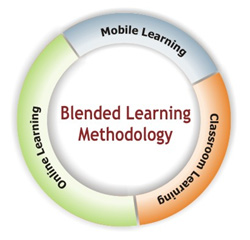Online learning has become more popular because of its potential for providing flexible access to content and instruction at any time from any place. Online learning often includes the following: increasing the availability of learning experiences for people cannot or choose not to attend traditional, face-to-face classes, assembling and distributing instructional content more cost-efficiently, and allowing instructors to handle more students while maintaining a high degree of effective teaching. Additionally, online learning courses are being designed to enhance the quality of learning experiences and outcomes. A common theory on education says that learning a complex body of information requires a community of learners, and online resources can expand and support these communities.
As technology continues to advance and become more available, both online courses and blended courses are becoming more popular. Sharon Roushdy, lead instructional designer with the learning technologies group at the University of Maryland, agrees with this notion, saying, "Both blended and online courses will continue to grow at the University of Maryland as technology gets better and better." Sharon Roushdy also explained that online classes have mainly been used in short semesters, such as summer and winter terms at the University of Maryland, while blended courses are becoming more widely used in courses during both fall and spring semesters.
For online and blended courses to be successful, the technology being used must be reliable and available to the entire class. With the explosion of laptops, tablets, and smart phones, many people are able to access the internet at all times. This is a big reason why blended and online class are increasing in popularity. In a study conducted by Educause Center for Applied Research in 2007, it was found that over 98% of college students responding to a survey own computers, nearly three-quarters of the respondents own laptops, and 83% had used a course management system that integrated an online component into their classes. Obviously, in the past four years, these numbers have increased to the point where virtually all college students either own a laptop or readily have access to them. Today, technology can easily be integrated in the classroom to any extent that the course calls for, enabling online and blended courses to be more practical and widespread.
Blended learning refers to a mixture of teaching techniques, including traditional, face-to-face meetings in addition to online components. Online courses take place entirely online, with no face-to-face meetings. Both blended and online learning styles have been found to be more effective than purely traditional ways of teaching. Based on a study conducted by the U.S. Department of Education, which can be found here, students who took all or part of their instruction online performed better, on average, than those taking the same course through face-to-face instruction. Furthermore, students who took blended courses performed the best of all. The study also said that online learning is much more conducive to the expansion of learning time than face-to-face instruction, which is a great advantage for promoting learning. Of the report, Education Secretary Arne Duncan said "This report reinforces that effective teachers need to incorporate digital content into everyday classes and consider open-source learning management systems, which have proven cost-effective in school districts and colleges nationwide." While both online and blended courses are useful, they each have their own advantages. Sharon Roushdy discusses these advantages in the following video.
In regards to blended learning, Sharon Roushdy points out the very important point that blended learning includes aspects of both traditional learning and online learning. Blended courses appeal to a wider group of students because they can get a feel for the online aspect of learning, without completely relying on it. Of course, some people do not have the ability to travel to a campus, but still want to take classes. Online courses provide them with a great opportunity to take part in a learning experience at their convenience. Sharon also points out that online courses are being improved by technologies, such as Web 2.0 and social media, which make them more similar to face-to-face classes.
In the following audio clip, University of Maryland student, Vas Blagodarskiy, explains why he thinks blended classes are the most effective.
listen to ‘Pros of Blended Courses’ on Audioboo
Vas agrees with Sharon Roushdy's comments on the advantages of blended courses; they are effective because they present information in a combination of ways, which better serves a
diverse group of learners. In the next clip, Vas talks more specifically on
Vas agrees with Sharon Roushdy's comments on the advantages of blended courses; they are effective because they present information in a combination of ways, which better serves a
diverse group of learners. In the next clip, Vas talks more specifically on
Vas agrees with Sharon Roushdy's comments on the advantages of blended courses; they are effective because they present information in a combination of ways, which better serves a
diverse group of learners. In the next clip, Vas talks more specifically on why he thinks blended courses are advantageous and describes an experience he had with a blended course.
Blended and online courses will continue to grow in the future because of more advanced technology, and because they are cost-effective, convenient, and, most of all, effective at helping students learn. As director of higher education at the American Federation of Teachers said, "Online learning and blended learning are growing components of higher education and, employed properly, can play a significant role in promoting student learning."
